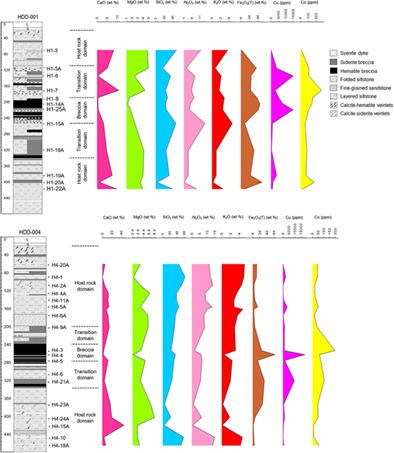当前位置:
X-MOL 学术
›
Resour. Geol.
›
论文详情
Our official English website, www.x-mol.net, welcomes your feedback! (Note: you will need to create a separate account there.)
Hydrothermal alteration and Cu–Co mineralization at the peripheral zone (Target H) of the Kitumba iron–oxide copper–gold system, Mumbwa District, Zambia
Resource Geology ( IF 1.4 ) Pub Date : 2021-07-22 , DOI: 10.1111/rge.12274 Mukuka Simusokwe 1 , Yasushi Watanabe 1 , Takuya Echigo 1
Resource Geology ( IF 1.4 ) Pub Date : 2021-07-22 , DOI: 10.1111/rge.12274 Mukuka Simusokwe 1 , Yasushi Watanabe 1 , Takuya Echigo 1
Affiliation

|
Target H is a new Cu prospect discovered in the Mumbwa district of central Zambia. Copper mineralization in the Mumbwa district is linked to the hydrothermal system associated with the granite-quartz syenite intrusions of the Hook batholith. The extent of the hydrothermal system has not been documented, but various Cu prospects, including Target H, have been discovered at the margins of the granite-quartz syenite bodies. The objective of this study is to investigate the geological characteristics of the Target H prospect using petrographic, geochemical, and sulfur isotope data in order to understand the features of mineralization at the margin of the hydrothermal system. The Cu- and Co-rich orebodies are hosted in siltstone and breccia correlated to the Kundelungu Group of the Neoproterozoic Katanga Supergroup rocks. The siltstone consists of alternating beds of sandstone and mudstone that are composed of diagenetic quartz, albite, dolomite, calcite, and muscovite. Breccia occurs parallel to the bedding planes and in the folded and fractured siltstone units. Lithostratigraphy is characterized by three domains: breccia, transition, and host rock, which are defined depending on the proportion of siltstone and breccia. The diagenetic minerals have been modified by hydrothermal alteration, resulting in alteration products controlled by the primary mineralogy of the host rocks: K-feldspar and muscovite replace albite and muscovite in siltstone, while siderite and hematite replace dolomite and calcite in breccia. Hydrothermal calcite is observed in the veinlets with or without siderite and hematite. Copper mineralization is associated with hydrothermal alteration and occurs as chalcopyrite, bornite, and chalcocite in breccia and stockwork veins. Diagrams correlating geochemistry to lithology show that the bulk of Cu mineralization is hosted in the breccia. An anomalous concentration of Co occurs with Cu in breccia, but the two metals do not show similar enrichment and depletion behaviors. The Cu-rich orebody forms in hematite-dominated breccia domain, whereas Co-rich orebody forms in siderite-dominated breccia units in the transition domain. In addition to Cu and Co, geochemical data show significant enrichment of Fe, P, Ba, Mo, Pb, W, U, V, and light rare earth elements in the breccia. Sulfur isotopic values of sulfide minerals show lighter δ34S values between 5 and 9‰ in the breccia and heavy δ34S signatures of approximately 17–28‰ in the siltstone. The δ34S values measured from sulfides in the breccia were comparable to the values obtained from the Kitumba deposit, which is located at the center of the hydrothermal system. We propose a magmatic-hydrothermal origin for the Cu- and Co-rich orebodies in the breccia at Target H. Breccia was the conduit for iron-oxide-rich metal-bearing fluids that originated from the Kitumba deposit. Cooling and reaction of the fluids with dolomite-rich siltstone triggered a redox reaction that deposited Cu sulfide minerals and an anomalous concentration of Co.
中文翻译:

赞比亚 Mumbwa 区 Kitumba 铁-氧化物铜-金系统外围带(目标 H)的热液蚀变和 Cu-Co 矿化
Target H 是在赞比亚中部的 Mumbwa 地区发现的一个新的铜矿床。Mumbwa 地区的铜矿化与 Hook 基岩的花岗岩-石英正长岩侵入体相关的热液系统有关。热液系统的范围尚未记录在案,但在花岗岩-石英正长岩体的边缘发现了包括目标 H 在内的各种铜矿前景。本研究的目的是利用岩石学、地球化学和硫同位素数据调查 Target H 勘探区的地质特征,以了解热液系统边缘的矿化特征。富含铜和钴的矿体位于粉砂岩和角砾岩中,与新元古代加丹加超群岩石的昆德伦古群相关。粉砂岩由砂岩和泥岩的交替层组成,由成岩石英、钠长石、白云石、方解石和白云母组成。角砾岩平行于层理平面并出现在折叠和破裂的粉砂岩单元中。岩性地层具有三个域的特征:角砾岩、过渡岩和主岩,这三个域的定义取决于粉砂岩和角砾岩的比例。成岩矿物经过热液蚀变改造,形成受母岩原生矿物控制的蚀变产物:粉砂岩中钾长石和白云母取代钠长石和白云母,角砾岩中菱铁矿和赤铁矿取代白云石和方解石。在有或没有菱铁矿和赤铁矿的细脉中观察到热液方解石。铜矿化与热液蚀变有关,在角砾岩和网状脉中以黄铜矿、斑铜矿和辉铜矿形式出现。地球化学与岩性相关的图表显示大部分铜矿化位于角砾岩中。角砾岩中的 Co 浓度异常与 Cu 一起出现,但这两种金属没有表现出相似的富集和消耗行为。富铜矿体形成于赤铁矿为主的角砾岩域中,而富钴矿体形成于过渡域中以菱铁矿为主的角砾岩单元中。除了 Cu 和 Co,地球化学数据显示角砾岩中 Fe、P、Ba、Mo、Pb、W、U、V 和轻稀土元素显着富集。硫化物矿物的硫同位素值显示较轻的δ 地球化学与岩性相关的图表显示,大部分铜矿化位于角砾岩中。角砾岩中的 Co 浓度异常与 Cu 一起出现,但这两种金属没有表现出相似的富集和消耗行为。富铜矿体形成于赤铁矿为主的角砾岩域中,而富钴矿体形成于过渡域中以菱铁矿为主的角砾岩单元中。除了 Cu 和 Co,地球化学数据显示角砾岩中 Fe、P、Ba、Mo、Pb、W、U、V 和轻稀土元素显着富集。硫化物矿物的硫同位素值显示较轻的δ 地球化学与岩性相关的图表显示,大部分铜矿化位于角砾岩中。角砾岩中的 Co 浓度异常与 Cu 一起出现,但这两种金属没有表现出相似的富集和消耗行为。富铜矿体形成于赤铁矿为主的角砾岩域中,而富钴矿体形成于过渡域中以菱铁矿为主的角砾岩单元中。除了 Cu 和 Co,地球化学数据显示角砾岩中 Fe、P、Ba、Mo、Pb、W、U、V 和轻稀土元素显着富集。硫化物矿物的硫同位素值显示较轻的δ 富铜矿体形成于赤铁矿为主的角砾岩域中,而富钴矿体形成于过渡域中以菱铁矿为主的角砾岩单元中。除了 Cu 和 Co,地球化学数据显示角砾岩中 Fe、P、Ba、Mo、Pb、W、U、V 和轻稀土元素显着富集。硫化物矿物的硫同位素值显示较轻的δ 富铜矿体形成于赤铁矿为主的角砾岩域中,而富钴矿体形成于过渡域中以菱铁矿为主的角砾岩单元中。除了 Cu 和 Co,地球化学数据显示角砾岩中 Fe、P、Ba、Mo、Pb、W、U、V 和轻稀土元素显着富集。硫化物矿物的硫同位素值显示较轻的δ角砾岩中的34 S 值介于 5 到 9‰ 之间,而粉砂岩中的重 δ 34 S 特征值约为 17–28‰。从角砾岩中的硫化物测得的 δ 34 S 值与从位于热液系统中心的 Kitumba 矿床获得的值相当。我们提出了 Target H 角砾岩中富含铜和钴的矿体的岩浆热液成因。角砾岩是源自 Kitumba 矿床的富含铁氧化物的含金属流体的通道。流体与富含白云石的粉砂岩的冷却和反应引发了氧化还原反应,沉积了硫化铜矿物和异常浓度的 Co。
更新日期:2021-09-27
中文翻译:

赞比亚 Mumbwa 区 Kitumba 铁-氧化物铜-金系统外围带(目标 H)的热液蚀变和 Cu-Co 矿化
Target H 是在赞比亚中部的 Mumbwa 地区发现的一个新的铜矿床。Mumbwa 地区的铜矿化与 Hook 基岩的花岗岩-石英正长岩侵入体相关的热液系统有关。热液系统的范围尚未记录在案,但在花岗岩-石英正长岩体的边缘发现了包括目标 H 在内的各种铜矿前景。本研究的目的是利用岩石学、地球化学和硫同位素数据调查 Target H 勘探区的地质特征,以了解热液系统边缘的矿化特征。富含铜和钴的矿体位于粉砂岩和角砾岩中,与新元古代加丹加超群岩石的昆德伦古群相关。粉砂岩由砂岩和泥岩的交替层组成,由成岩石英、钠长石、白云石、方解石和白云母组成。角砾岩平行于层理平面并出现在折叠和破裂的粉砂岩单元中。岩性地层具有三个域的特征:角砾岩、过渡岩和主岩,这三个域的定义取决于粉砂岩和角砾岩的比例。成岩矿物经过热液蚀变改造,形成受母岩原生矿物控制的蚀变产物:粉砂岩中钾长石和白云母取代钠长石和白云母,角砾岩中菱铁矿和赤铁矿取代白云石和方解石。在有或没有菱铁矿和赤铁矿的细脉中观察到热液方解石。铜矿化与热液蚀变有关,在角砾岩和网状脉中以黄铜矿、斑铜矿和辉铜矿形式出现。地球化学与岩性相关的图表显示大部分铜矿化位于角砾岩中。角砾岩中的 Co 浓度异常与 Cu 一起出现,但这两种金属没有表现出相似的富集和消耗行为。富铜矿体形成于赤铁矿为主的角砾岩域中,而富钴矿体形成于过渡域中以菱铁矿为主的角砾岩单元中。除了 Cu 和 Co,地球化学数据显示角砾岩中 Fe、P、Ba、Mo、Pb、W、U、V 和轻稀土元素显着富集。硫化物矿物的硫同位素值显示较轻的δ 地球化学与岩性相关的图表显示,大部分铜矿化位于角砾岩中。角砾岩中的 Co 浓度异常与 Cu 一起出现,但这两种金属没有表现出相似的富集和消耗行为。富铜矿体形成于赤铁矿为主的角砾岩域中,而富钴矿体形成于过渡域中以菱铁矿为主的角砾岩单元中。除了 Cu 和 Co,地球化学数据显示角砾岩中 Fe、P、Ba、Mo、Pb、W、U、V 和轻稀土元素显着富集。硫化物矿物的硫同位素值显示较轻的δ 地球化学与岩性相关的图表显示,大部分铜矿化位于角砾岩中。角砾岩中的 Co 浓度异常与 Cu 一起出现,但这两种金属没有表现出相似的富集和消耗行为。富铜矿体形成于赤铁矿为主的角砾岩域中,而富钴矿体形成于过渡域中以菱铁矿为主的角砾岩单元中。除了 Cu 和 Co,地球化学数据显示角砾岩中 Fe、P、Ba、Mo、Pb、W、U、V 和轻稀土元素显着富集。硫化物矿物的硫同位素值显示较轻的δ 富铜矿体形成于赤铁矿为主的角砾岩域中,而富钴矿体形成于过渡域中以菱铁矿为主的角砾岩单元中。除了 Cu 和 Co,地球化学数据显示角砾岩中 Fe、P、Ba、Mo、Pb、W、U、V 和轻稀土元素显着富集。硫化物矿物的硫同位素值显示较轻的δ 富铜矿体形成于赤铁矿为主的角砾岩域中,而富钴矿体形成于过渡域中以菱铁矿为主的角砾岩单元中。除了 Cu 和 Co,地球化学数据显示角砾岩中 Fe、P、Ba、Mo、Pb、W、U、V 和轻稀土元素显着富集。硫化物矿物的硫同位素值显示较轻的δ角砾岩中的34 S 值介于 5 到 9‰ 之间,而粉砂岩中的重 δ 34 S 特征值约为 17–28‰。从角砾岩中的硫化物测得的 δ 34 S 值与从位于热液系统中心的 Kitumba 矿床获得的值相当。我们提出了 Target H 角砾岩中富含铜和钴的矿体的岩浆热液成因。角砾岩是源自 Kitumba 矿床的富含铁氧化物的含金属流体的通道。流体与富含白云石的粉砂岩的冷却和反应引发了氧化还原反应,沉积了硫化铜矿物和异常浓度的 Co。


























 京公网安备 11010802027423号
京公网安备 11010802027423号